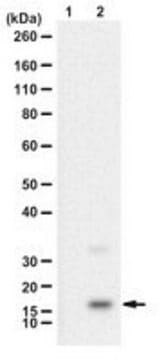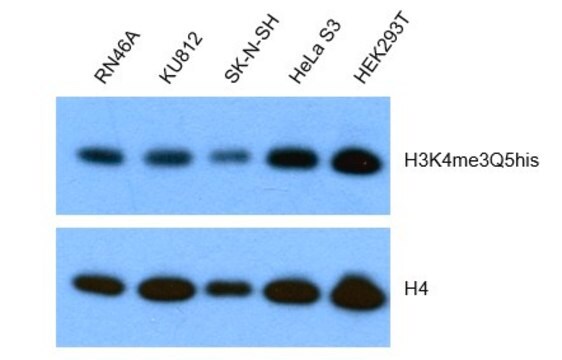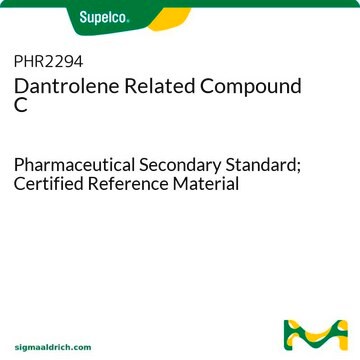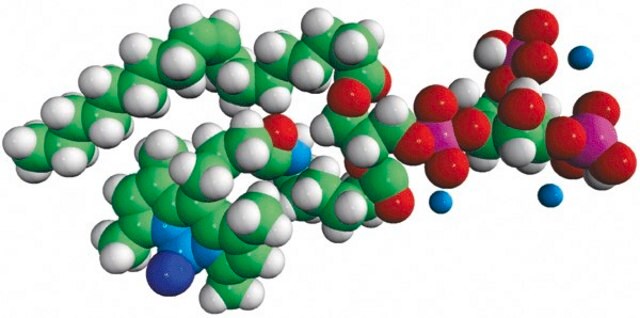ABE2578
Anti-H3Q5histaminyl
Synonyme(s) :
Histone H3Q5;H3Q5;Histone H3 glutamine5 Histaminyl
About This Item
Produits recommandés
Source biologique
rabbit
Niveau de qualité
Conjugué
unconjugated
Forme d'anticorps
purified antibody
Type de produit anticorps
primary antibodies
Clone
polyclonal
Poids mol.
calculated mol wt 15.51 kDa
observed mol wt ~16 kDa
Espèces réactives
human
Réactivité de l'espèce (prédite par homologie)
bovine, monkey
Conditionnement
antibody small pack of 100 μL
Technique(s)
dot blot: suitable
western blot: suitable
Isotype
IgG
Séquence de l'épitope
N-terminal
Numéro d'accès Protein ID
Numéro d'accès UniProt
Conditions d'expédition
ambient
Modification post-traductionnelle de la cible
histaminylation (Gln6)
Informations sur le gène
human ... HIST3H3(8290)
Description générale
Spécificité
Immunogène
Application
Evaluated by DOT Blot analysis with H3Q5Histaminyl peptide
Dot Blot Analysis: A 1:1,000 dilution of this antibody detected H3Q5Histaminyl peptide, but not the unmodified H3Q5 peptide.
Tested Applications
Western Blotting Analysis: A representative lot detected H3Q5histaminyl in lysate from Transglutaminase 2 (TGM2) overexpressing HEK293T cells treated with Histamine, but not in untreated cells or in cells treated with Serotonin or Dopamine. (Data courtesy of Dr. Ian Maze′s Lab, Icahn School of Medicine at Mount Sinai, New York).
Western Blotting Analysis: A 1:1,000 dilution of this antibody detected Histone H3Q5histaminyl in lysates from HEK293T cells over expressing TGM2 and treated with histamine, but not in untreated cells.
Dot Blot Analysis: A 1:1,000 dilution of a representative lot of this antibody detected H3Q5histaminyl peptide, but not serotonin or dopamine modified peptides. (Data courtesy of Dr. Ian Maze s Lab, Icahn School of Medicine at Mount Sinai, New York).
Activity Assay (In vitro): A representative lot of this antibody detected the recombinant Histone H3.3 histaminylated on glutamine 5 following in vitro transamidation reaction in the presence of histamine. (Data courtesy of Dr. Ian Maze Lab, Icahn School of Medicine at Mount Sinai, New York).
Note: Actual optimal working dilutions must be determined by end user as specimens, and experimental conditions may vary with the end user
Forme physique
Stockage et stabilité
Autres remarques
Clause de non-responsabilité
Not finding the right product?
Try our Outil de sélection de produits.
Code de la classe de stockage
12 - Non Combustible Liquids
Classe de danger pour l'eau (WGK)
WGK 1
Point d'éclair (°F)
Not applicable
Point d'éclair (°C)
Not applicable
Certificats d'analyse (COA)
Recherchez un Certificats d'analyse (COA) en saisissant le numéro de lot du produit. Les numéros de lot figurent sur l'étiquette du produit après les mots "Lot" ou "Batch".
Déjà en possession de ce produit ?
Retrouvez la documentation relative aux produits que vous avez récemment achetés dans la Bibliothèque de documents.
Notre équipe de scientifiques dispose d'une expérience dans tous les secteurs de la recherche, notamment en sciences de la vie, science des matériaux, synthèse chimique, chromatographie, analyse et dans de nombreux autres domaines..
Contacter notre Service technique